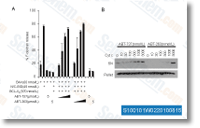An preliminary 9. 9X sequen cing data was sequenced from a combination of 2%, 8% and 90% on the reads in the 40 kb, 6 kb and two kb libraries, respectively. The Phred/Phrap/Consed software program package was implemented for genome assembly and gap closure in accordance towards the paired ends from your sizeable insert libraries. The remaining physical gaps that have been derived from the unclonable areas have been linked by means of combinatorial multiplex PCR screening of primers developed from the contig ends. Autofinish was used for guiding, either by clone end resequen cing or primer strolling over the clones or PCR merchandise to achieve the conventional that every base was covered by at least two independent higher high-quality reads and that has a Phred superior value Q40. Large repetitive areas have been resolved by primer walking above long PCR solutions amplified from your corresponding regions. In all, 119316 reads had been pro duced, which amounted to a last sequencing depth of twelve.
5X. Genome annotation and analysis Gene finding and function assignment ORFs special info have been initially predicted by Glimmer 3. 02 using a threshold of one hundred bp. The intergenic areas had been subjected to blastx hunting against the nonredundant information base for unrecognized ORFs. All predicted genes have been translated into amino acid sequences for homologue searches using the InterPro, Cluster of Orthologous Groups and nonredundant databases. Functional assignments and begin web sites for each ORF have been deter mined manually by combining the search success from these sources. Transfer RNA genes were predicted with tRNAscan SE and rRNA genes had been situated through homologue searches. The annotated proteins had been fur ther assigned to practical groups in accordance for the Com prehensive Microbial Resource role class. The putative bacteriocin gene clusters were classified, accord ing to strategies described previously.
Hypothetical proteins have been defined as conserved if they had at the least 30 homologues with total length matching in other gen omes, when unique hypothetical proteins had no complete length matching in other genomes. Pseudogenes The pseudogenes were examined manually implementing Artemis BIBR1532 for frameshift and premature halt codons, as well because the boundaries with the truncation, deletion and insertion. The boundaries of truncated pseudogenes were established as a result of it erative BLAST searches for your surrounding regions. The pseudogenes have been assigned a perform in accordance to your hits of the homologue search with substantial similarity. IS and MITE The ISs were recognized and classified applying the ISfinder database. Fifteen MITEs have been initially identified as insertions  from interrupted pseudogenes. Extra MITEs had been observed by blastn searching the 15 insertions against the full genome sequence. Frag mented MITEs with above 50% coverage have been counted as partial.
from interrupted pseudogenes. Extra MITEs had been observed by blastn searching the 15 insertions against the full genome sequence. Frag mented MITEs with above 50% coverage have been counted as partial.
PCNA signal
PCNA is a member of the so called DNA
